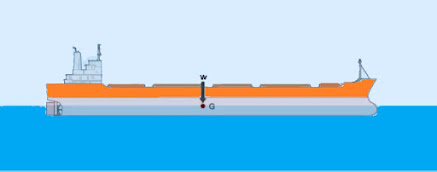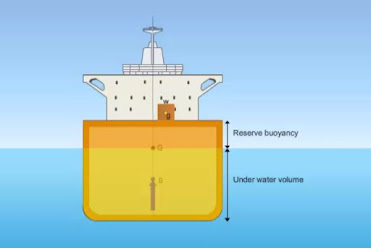Static stresses
Hogging:
- Longitudinal bending stresses could be caused while loading the ship in still water.
- Hogging is a stress that causes the ship's hull or keel to bend upwards at amidships.
- Look at the effect when the load concentration is more on the ends of the vessel.
- The ship structure bend downwards at the end.
Sagging:
- When load concentration is more at the centre, the structure tends to bend downwards in the middle.
- This action is called sagging.
- The vessel is designed with the certain allowable maximum bending moment and shear forces which are tabulated in the approved ship's stability booklet.
- The loading and distribution of weights will be monitored by chief officer of the vessel according to the prescribed limits with the help of a load indicator and stability booklet.
- He is responsible for minimizing this 'SAG' and 'HOG' of the vessel.
- When the ship is in a dry dock, a ship's sides are no longer supported by water pressure.
- The only things holding the ship are keel blocks, bilge blocks and side shores.
- The result is that the sides of the ship tend to bulge outwards and the bottom tends to sag.
- To counteract drydocking stress, the entire bottom of a ship is strengthened.
- Fluctuation in water pressure causes in and out movement of a ship's side plating at bow and stern.
- This movement results in panting stress.
- It is more pronounced at the bow, which pushes the bow ahead into the water or swell.
- This stress is compensated by fitting panting beams with a distance of two metres between every alternate frames.
- The panting beams are connected to the frames by beam knees and supported by a wash plate at the Centre.
- Side stringers, in line with panting stringers, are fitted throughout this deep framing region.
- Breast hooks fitted to support the radiused stem plate and to prevent in and out movement of the side shell.
- Pounding stress occurs at the bottom plating of a ship near the bow during excessive pitching.
- To compensate slamming down of a ship's bottom, outer bottom plating is thickened and connections to inner shell and inner bottom girder are strengthened.
- The thickness of plates near the pounding is increased by thirty percent and transverse frame spacing is reduced from nine hundred millimeters; to seven hundred millimetres.
- Solid floors fitted at every frame space are welded to the bottom shell and transverse floors are fitted at alternate frames.
Water pressure:
Drydock:
Localised stress:
When a heavyweight is loaded over a small area or if there is a concentration of weight in a particular area, it causes localized stresses.
Localized stress is counteracted by extra strengthening.
Dynamic stresses
Panting stress:
Pounding stress:
Racking stress:
- This stress is more pronounced on the corners of the ship due to wave action on the hull.
- Racking stresses are reduced by fitting beam knees and tank side brackets.
- But the most effective way to resist racking is to fit transverse bulkheads.




















